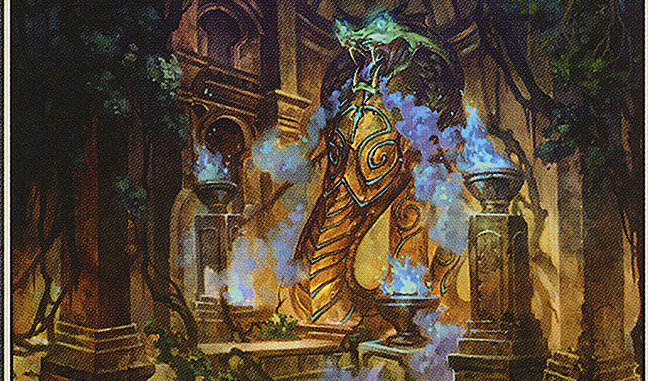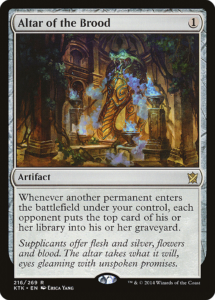
We’re back with another installment of MtG to D&D, a semi-regular series where we bring cards from Magic the Gathering into something you can use in your 5th Edition D&D games. The past several have featured cards that could be modified into magic items that could be handed out to players. This time I’m going to take a look at a card that could be adapted into an addition to a final encounter of an adventure – The Altar of the Brood.
Now the mechanics for this card feature some things that don’t appear to translate to 5th Edition rules at first glance. It states that every time another permanent enters the battlefield under your control, every opponent must mill the top card of their deck, which means that it goes right from the top of your deck to your graveyard without entering play. So, how can this be translated to 5th Edition rules? Well, if you mill enough of your deck and can’t draw a card when you’re instructed to you lose the game. This actually reminds me of the exhaustion mechanic in 5th Edition. As you take mounting levels of exhaustion, you take increasingly severe penalties, and if you hit a certain level of it, you die.
So how can we take this card and turn it into an encounter piece for your D&D game?

“You enter the central chamber of the cathedral, a raised walkway running around the perimeter of the room with multiple stairways and ramps descending into the center, many of them blocked off preventing easy access. Sitting in the middle is a large altar, carved from some unknown stone, covered in various runes, humming with power. The leader of the cult you’ve been tracking down stands before it with several of his acolytes, chanting words of power. As he finishes, he looks directly at you, a wicked smile on his face. Portals open up on either side, a large spider skittering through each one. As they step into the room, the runes pulse and a chill sweeps through you, one that feels like it’s attacking your very life force to draw power the summoning. Make a Constitution saving throw.”
This altar is covered with arcane runes that have strong Conjuration magic. When it’s active (which requires a ritual), you can use your action to attempt a DC 15 Arcana check. If successful, you summon two beasts of CR 1/2 or lower that enter the battlefield on either side of the altar. When this happens, all living creatures within 120 feet of the altar that weren’t involved with the activation ritual must make a DC 12 Constitution saving throw or suffer 1 level of exhaustion. These summoned creatures fight for whoever activated the altar.
There are a number of ways that a creature can attempt to interfere with the power of the altar. An arcane or divine spellcaster can attempt a DC 20 Arcana or Religion check as an action on their turn. If successful, they can interfere with the magic of the runes, imposing disadvantage on the Arcana check the next time it’s activated. Two of these checks before a successful summoning succeeds in blocking the power of the altar for two rounds. Three such checks before a successful summoning action blocks the power of the altar for 1 minute. A Dispel Magic spell also blocks the power of the altar for 1 minute. The altar is the equivalent of a 5th level spell, but the power imposes disadvantage on the ability check made as part of the spell. Additionally, the altar can be attacked directly. It has an Armor Class of 17 and 44 hit points. It has resistance to slashing damage and from weapons with the “light” trait and is immune to damage from ranged weapons. Successfully reducing the altar to 0 hit points doesn’t destroy it, but damages it so that it can no longer be used without repairing it, an arcane ritual that requires intensive time and resources.
Needless to say, this altar could produce a lot of creatures very quickly, which could overwhelm your PCs, especially if they start to fail a number of Constitution saving throws. Those levels of exhaustion can quickly cause a spiral of further failed saves, so be careful at what level you pit this device against your players. That said, there could be a long buildup of them investigating a cult that is using this altar to attack settlements with swarms of beasts and secure dominance in an area, finally tracking down their base of operations and forcing a showdown with the cult leaders.
How would you use this altar in your own games?
